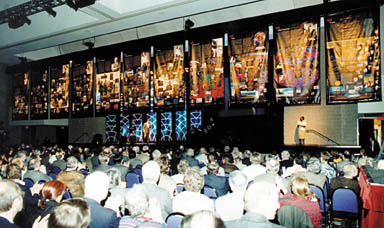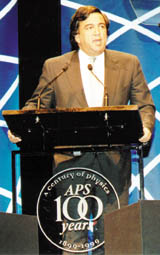 The unveiling the APS timeline wall chart at the APS Centennial meeting |
Bill Richardson, US Secretary of Energy, delivered the keynote address at the APS Centennial meeting on Monday evening, March 22, to a packed room of physicists in town for the biggest physics meeting in the world. Also presiding at the event — which culminated with the unveiling of the APS timeline wall chart — were APS President Jerome Friedman (Massachusetts Institute of Technology), William Brinkman of Lucent Technologies, and Robert Eisenstein of the National Science Foundation.
Richardson opened with a recognition of the vital role physics has played in the last century. "This century of physics has done more than merely make significant discoveries... it has fundamentally altered how we think of the universe and of the forces that bind it together," he said. "Whether it is basic science, national defense, energy research or environmental quality, physics is the enabler and provider of solutions, an inseparable part of our livelihoods."
But the majority of Richardson's talk focused on the future, beginning with a summation of President Clinton's efforts to promote world leadership in basic science, mathematics and engineering for the US, emphasizing the goals set out in the 1994 study Science in the National Interest, undertaken by the presidential Council of Advisors. These include enhancing connections between fundamental research and national goals; stimulating partnerships that promote investments in fundamental science and engineering, and raising the scientific and technological literacy of all Americans. In addition, the Information Technology for the 21st Century initiative, will, he said, "enable us to develop and deploy new, faster computers for advanced simulation," providing "powerful tools to design a new generation of cars, develop new pharmaceuticals, and help us improve our weather and climate research."
 US Secretary of Energy Bill Richardson delivered the keynote address. |
Another area of concern to Richardson — one that has been echoed by many scientists and government representatives alike in recent years — is the need to improve communication between the American people and the physics community. To most Americans, physics is an inaccessible subject that "many people gladly left behind in high school," he said. Translating physics research into plain English — "decoding" it for the public similar to the way in which medical breakthroughs are presented for general consumption — is critical for accomplishing this.
Richardson also took the opportunity to respond to recent Congressional calls for heightened security at DOE laboratories. The issue came to the fore in recent weeks after a Taiwan-born American Los Alamos scientist was accused of passing nuclear secrets to China. Richardson vowed to "maintain and strengthen the tall fences that protect the nation's secrets," but added, "We can't be intimidated into closing ourselves off. It is critical that our laboratories — which house so many of our important research facilities and our finest scientists — do not become isolated from the world."
Pledging to fight any proposal to close off American science, Richardson emphasized the DOE's dedication to technological and scientific innovation, which is crucial if the country is to remain a global leader in the next millennium. With this goal in mind, he reported that the DOE is dedicated to improving the opportunities of well-trained scientists to pursue innovative research, to educate the next generation of scientists, and to apply science in all areas of importance in the U.S. "I don't know what the next century will bring, but I am doing what I can to ensure the right conditions that science will continue to flourish in the 21st century."
Richardson concluded his speech with a dramatic unveiling — complete with drum rolls — of "A Century of Physics," a timeline wall chart funded by Lucent Technologies as well as the Department of Energy, National Science Foundation and United Parcel Service, to mark the APS Centennial. Excerpted monthly in APS News for the past year, the chart chronicles the discoveries of physics and their impacts on each decade of the 20th century. The full-sized panels were displayed April 14 in the foyer of the Rayburn Congressional office building in Washington, DC, and will be distributed free of charge to 20,000 colleges, universities, high schools, libraries and science centers throughout the country.
A complementary website has been developed with support from IBM Corporation which allows more in depth exploration of the timeline. The website address is www.timeline.aps.org.
©1995 - 2024, AMERICAN PHYSICAL SOCIETY
APS encourages the redistribution of the materials included in this newspaper provided that attribution to the source is noted and the materials are not truncated or changed.
Editor: Barrett H. Ripin
Associate Editor: Jennifer Ouellette
May 1999 (Volume 8, Number 5)
Articles in this Issue

